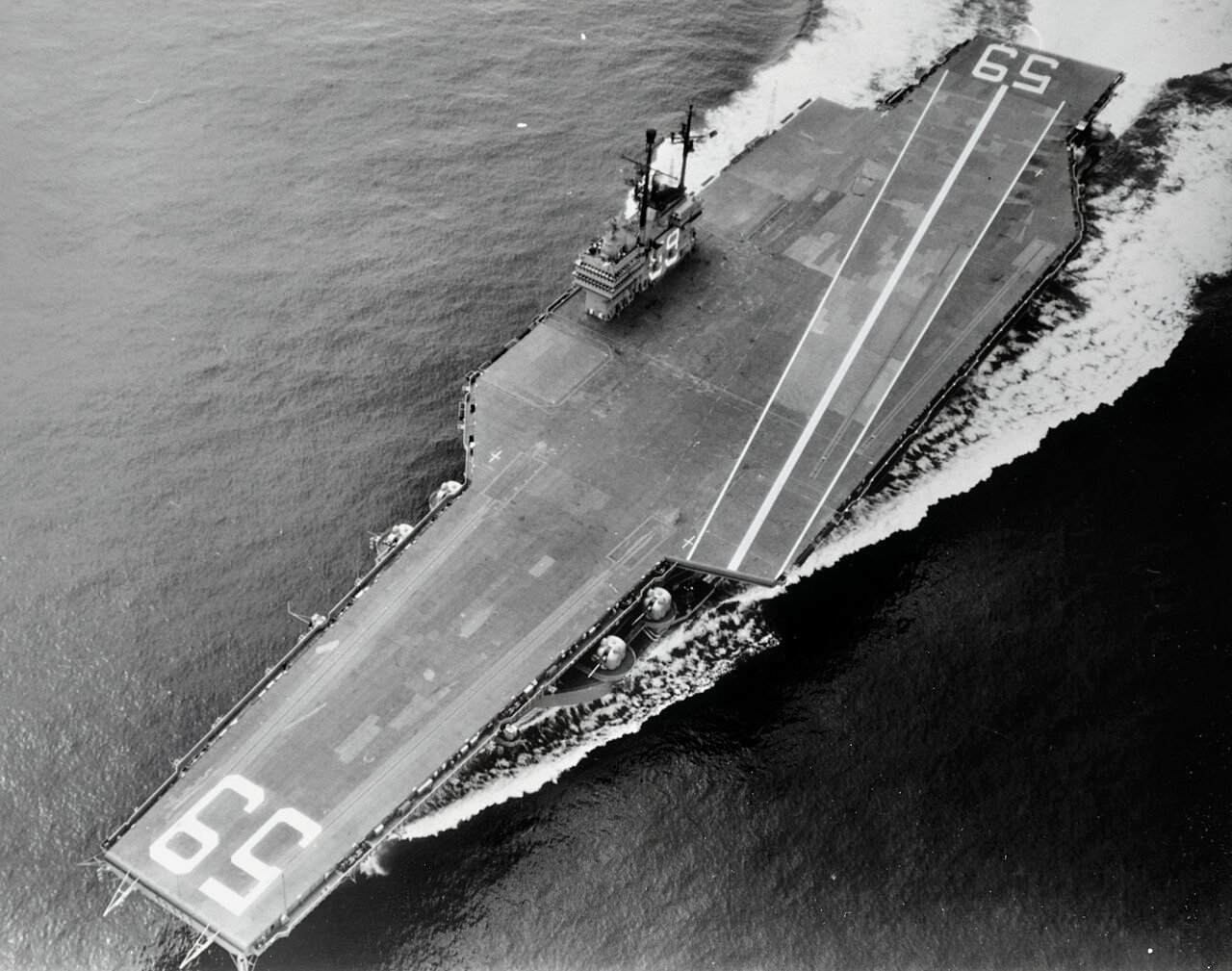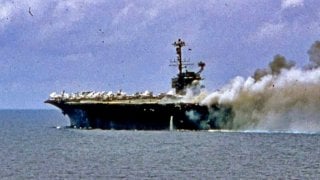USS Forrestal: Triumph and Tragedy of America's First 'Super' Aircraft Carrier
The USS Forrestal, the U.S. Navy's first supercarrier and part of the Forrestal-class, played a pivotal role during the Vietnam War, particularly at Yankee Station in 1967.
Summary: The USS Forrestal, the U.S. Navy's first supercarrier and part of the Forrestal-class, played a pivotal role during the Vietnam War, particularly at Yankee Station in 1967. Named after James Forrestal, America's first secretary of defense, the Forrestal was launched in 1954 and introduced significant advancements in carrier design, including a capacity for simultaneous aircraft launches.
-Despite its technological advancements and massive airwing, the Forrestal's service was marked by a catastrophic fire on July 29, 1967, which killed 134 sailors and destroyed or damaged over 110 aircraft.
-The incident, caused by an accidental rocket launch during crowded deck operations, led to extensive safety reviews and operational changes in the Navy. Repaired and returned to service, the Forrestal continued to serve until its decommissioning, with its materials finally scrapped in 2015.
From Launch to Legacy: The Storied Career of the USS Forrestal
By 1967, the U.S. Navy had transitioned itself into a surface fleet of supercarriers. Three main classes defined this new age of supercarriers. The Kitty Hawk-class, the Forrestal-class, and the Enterprise-class supercarrier (the world’s first nuclear-powered class of carrier) all prowled the deep blue seas, protecting American interests.
At this time, the United States was in the second year of what would become one of its costliest, failed conflicts, the Vietnam War.
Until 1967, the American carriers that supported the Vietnam War effort all belonged to the Pacific Fleet. However, by this time, as the war dragged on and greater resources were required to defeat the North Vietnamese, assets from beyond the Pacific were needed.
Supercarriers like the USS Forrestal (CV-59) belonged to the Atlantic Fleet. However, they were repurposed to support the ongoing war effort in Vietnam. Thus, the Forrestal became a key strategic asset as the air war over Vietnam got hotter each year that the war continued.
USS Forrestal was named after America’s first secretary of defense, James Forrestal (who was incidentally committed to a mental institution before supposedly throwing himself from his window and dying in a successful suicide attempt). It was the first supercarrier that the United States had constructed. Three other warships joined the class: the USS Ranger (CV-61), the USS Saratoga (CV-60), and the USS Independence (CV-62). These carriers were non-nuclear, but they were one of the Navy’s most successful carriers of the postwar period.
Some Details About the Forrestal
The Forrestal was powered by four Westinghouse geared steam turbines and eight Babcock & Wilcox boilers. It was launched on December 11, 1954, from Newport News, Virginia. The Navy took ownership of the vessel a year later, on September 29, 1955.
According to an assessment by the website MilitaryFactory.com, the USS Forrestal “set the standard for American carriers to come. She featured her island superstructure offset to starboard with multiple hangar elevators used to service the flight deck and hangar decks below.” What’s more, “four aircraft could be launched simultaneously.”

The Forrestal carried a large, mixed airwing of both rotary craft and fixed-wing aircraft. The warship carried 552 officers commanding 4,988 enlisted sailors. When under standard load, she displaced 60,610 tons and 82,402 tons when under full load.
Forrestal had a maximum speed of thirty-seven miles per hour and a range of 9,200 miles. These warships were truly the Navy’s standard-bearers for all subsequent carriers, both conventionally powered and nuclear-powered. The only problem for the USS Forrestal was the fact that its otherwise impressive and lengthy service record was marred by onboard fires. Notably, one major fire nearly destroyed the warship in 1967.
Yankee Station was the name of the region of the open Pacific Ocean near Vietnam’s coast where U.S. warships rallied and conducted their operations against the communist forces fighting the American and South Vietnamese armies for control of Vietnam.
Arriving at Yankee Station
As John B. Nichols and Barrett Nichols documented in their fabulous book On Yankee Station: The Naval Air War Over Vietnam, U.S. naval operations directed against Vietnam had to be conducted from a distance because the geography of Vietnam—it being mostly along the waters of the Tonkin Gulf, which was far too small of a space for U.S. carriers to safely operate inside of—at two points in the Pacific Ocean.
The first position was “Yankee Station,” just south of China’s Hainan Island, from which direct strikes against North Vietnam were launched. The other location was “Dixie Station” off of South Vietnam’s coastline (airstrikes into neighboring Laos and Cambodia were launched from Dixie Station).
Forrestal had arrived at Yankee Station on July 25, 1967.
The Forrestal Begins Its Attack on North Vietnam
The Forrestal’s airwing launched its initial strikes from Yankee Station the next morning—at 0600 (that’s 6 a.m.). Over the next four days, the Forrestal conducted an admirable 150 sorties against targets deep inside the heavily defended North Vietnam without losing a single plane.
As noted above, the Forrestal-class supercarrier had a massive flight deck—far larger than any other conventionally powered carrier in the American fleet. Unlike the older Essex-class carriers that fought in the Second World War, the planes launched from the Forrestal’s flight deck were jets.
A Crisis Unlike Any Other…
But the flight deck on July 29, 1967, was massively crowded.
There were up to twenty warplanes ready for launch, and another twenty were in the queue behind them. Some reports indicate that there was “barely any walking room” between the warbirds that were lined up on the flight deck that day. Everyone onboard was itching to deploy and prove that the Forrestal was the best warship in the fleet. They’d already had such a good run on this deployment.
In the chaos of that moment, rather than deploy the mother-of-all airstrikes against communist targets in North Vietnam, an explosion rocked the flight deck, setting the supercarrier ablaze. The explosion and ensuing fire almost resulted in the loss of the Forrestal. Yet, her crew was able to come together and save the ship.
Sadly, 134 sailors were lost that day when the crisis ended.
Was John McCain to Blame? No.
Interestingly, a young Lieutenant John McCain was lined up for launch on the flight deck when the explosion occurred. Over the years, McCain has been both a source of inspiration for his service in the Vietnam War and a consternation for his subsequent time as a Republican Party United States senator representing Arizona.
One source of controversy that dogged McCain for years was the unsubstantiated claim that he caused the great conflagration.
McCain was a brash, young pilot. He was known as a hotdog. McCain was accused of performing what’s known as a “wet start” on his bird. This basically causes fuel to build up in the engine before the plane is engaged. Needless to say, it’s a highly reckless and unauthorized maneuver. Subsequent investigations, however, determined that McCain was not the cause of the accident.
The Official Cause of the Fire
Officially, the fire began after a five-inch Zuni rocket mounted on one of the carrier’s F-4B Phantom II fighters suffered a technical glitch when an “errant” electrical charge sent that rocket launching toward an external fuel tank of an A-4E Skyhawk attack bomber located 100 feet across from the crowded deck from the F-4B. The A-4 that was impacted by the errant Zuni rocket then suffered additional electrical shorts in its damaged weapons systems, sending one of the two 1,000-pound bombs under its wing onto the burning deck below the damaged A-4.
Just as fire crews were arriving to douse the fires on the overcrowded flight deck with saltwater from the nearby sea, the 1,000-pound was detonated by the fires it had fallen into. The fire crews were incinerated immediately. In five minutes, the great warships sustained historic amounts of damage that a carrier had not endured since the darkest days of WWII—meanwhile, an additional seven 1,000-pound bombs detonated amid the fire on the aft flight deck.
The ship’s two-inch-thick armor plating was riddled with holes resulting from the massive explosions. On top of the 134 sailors who died that day, an additional 161 were injured. Seventy-three aircraft were destroyed onboard the carrier that day, with another forty damaged. Carrier repairs ultimately cost $72 million, while repairing or replacing the airwing cost an additional $40 million.
It was determined that the Zuni rocket was triggered accidentally when the F-4 pilot switched power sources for his plane in preparation for launch that day. It created a cascade of horrible events. However, several lessons were learned that have been passed down to subsequent warships. The Forrestal fire was catastrophic, but it was also a painful, though necessary, teachable moment for the U.S. Navy. The ship was saved because of the quick-thinking, as well as the excellent training and leadership of the ship’s crew.
After this incident, the Forrestal was repaired and redeployed, where she went on to have a storied service record for decades beyond the Vietnam War. In fact, after she was decommissioned, her final metals were scrapped as late as 2015.


